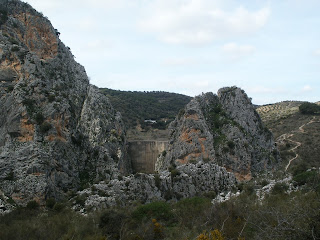Montejaque, Benaojan, Jimera de Libar, Cortez de la Frontera, Algatocin, Guadalguacin, Algatocin, Benaluria, Benadalid Ronda.
One of the free Spanish classes trips took us to the Genal valley. There were two coaches of people who’s classes involved learning English, maths, Spanish and Spanish. The last part of the sentence is not a mistake. There were two classes learning Spanish. One was the English learning Spanish and the other was the Spanish learning Spanish. Many of the 60+ Spanish cannot read or write their own language. They grew up in a time when there were no formal classes or schools for their own language.
When they reached maturity they were in a nightmare world where the military and church suppressed learning. If you were caught reading newspapers to the illiterate during Franco’s time the police would take you away and you would never be seen again.
Try to find a film called La Voz Dormida. It is in Spanish, but you will understand the plot even if you only have a little Spanish. It portrays the horrors of those times. There is a house here in Olvera with a big cellar where, as the story goes, two hundred men hid. Food was thrown over the walls of the garden by the people of the village. Their waste was taken away at night by the villagers. I can believe it.
The people who could read and write or simply critical of the regime disappeared. Now in 2013, their relatives are seeking the graves of their grandparents who were killed during the Franco years.
The third class, maths, again for the 60+ who could not do simple arithmetic on paper. However, don’t assume that because they cannot write basic arithmetic they are incapable of adding and subtracting in their heads. You will never see a native Spaniard short changed in a shop. They will bring the roof down for such an offence. I have played dominoes and cards with these guys and they are very clever.
The road to Montejaque leaves the A374 to Ronda and winds down a scary narrow road looking over a huge mound of detrius which has fallen from El Tejar, a huge slab of stratified limestone. It was here that the Spanish decided to build a dam and trap the waters that normally flowed through the the Hundidero cave system. The dam was constructed and everybody waited to it to fill. This is karstic country. Limestone dissolves over the centuries and fissures form, which allow water to find a way to lower levels.
The dam never filled. The water always found another way out.
Having said that in the floods of 2010 it did fill half way up because the fissures could not get the water away fast enough.
These pueblos were once part of a highway for traders and soldiers. The ports of Tarifa and Algeciras were the source of imported goods brought by the Almoravids who forged an empire between the 11th and 13th centuries with it’s capital in Marrakech. Their dominion stretched from Senegal to the kingdoms of Al-Andalus In the middle of the 12th century they were replaced by the Almohads (The Uniterians.) from the Atlas mountains after a great war. To supply and fortify their empires they both used the Genal valley. The route carried on to the east after Ronda through Teba, Campillos and finally to Granada. The Genal valley is one of the most picturesque places in Europe. Look at the photos and judge for yourself.
Benalauria
If you stop and think about it, this beautiful country has been trampled and fought over from the beginning of humanity. Do you think we will ever learn?
Jimera de Libar
Cortez de la Frontera
We left the A369 to look at a small pueblo with a breathtaking view over the Genal valley. Guadalguacin is also famous for it's concursos de escultura. This is an annual event where sculptors are invited to submit a work. If they win they receive a cash prize and the sculpture stays in the pueblo on show. The heads carved in the old olive tree stump are one of the winners. The figures on the wall are another.
We had all stopped for a tapas in one of the pueblos around three in the afternoon and after visiting Guadalguacin we set off back to Olvera. by the time we got back we were ready to have a beer together and compare notes on the day.








No comments:
Post a Comment